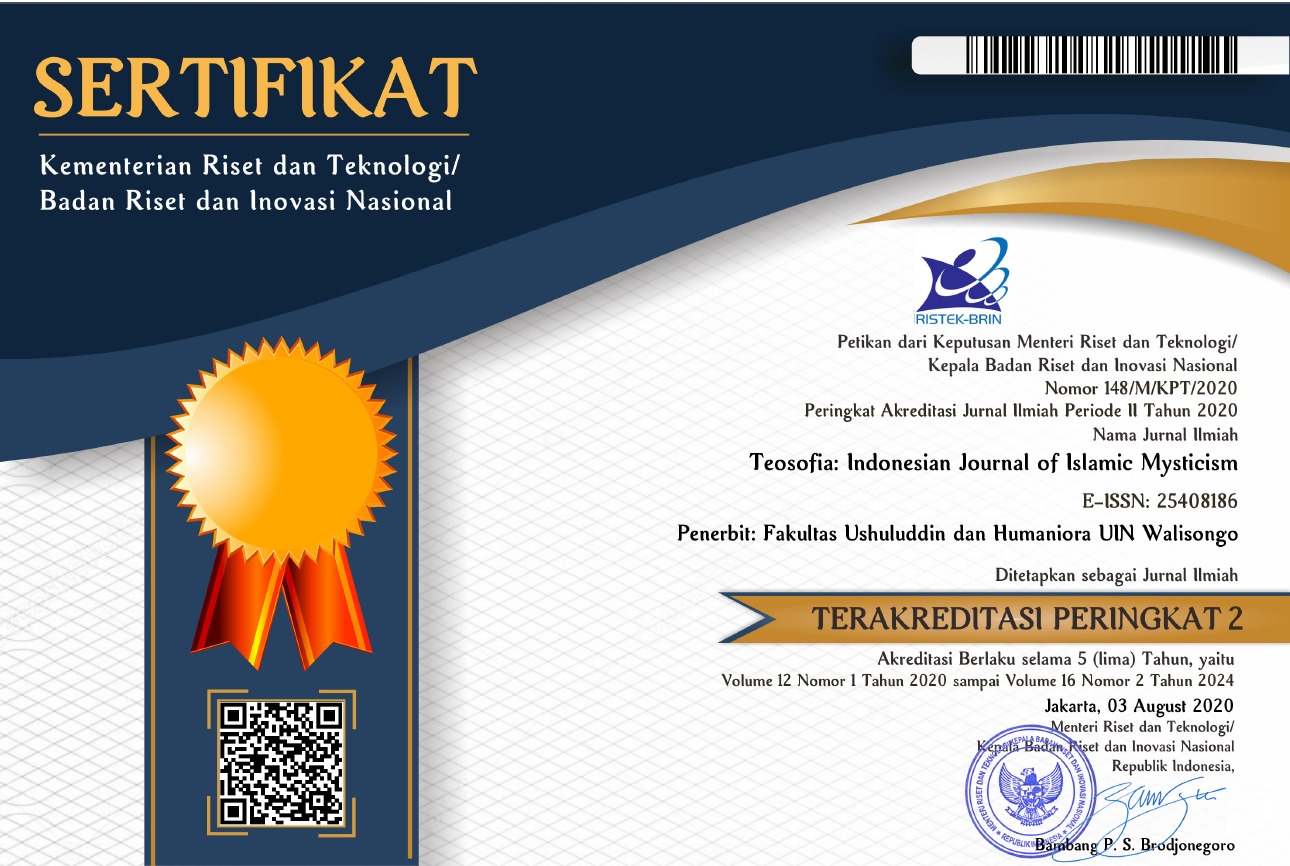REDEFINING THE CONCEPT OF ASCETICISM (ZUHD) IN TASAWWUF:ABUL HASAN ASH-SHADHILI’S VIEW AND HIS TARIQA SHADHILIYYA
DOI:
https://doi.org/10.21580/tos.v8i1.5225Keywords:
Syadzili, Wealth, Qur’an, HadithAbstract
Lots of the Muslims still consider that poverty is the way to get closer (taqarrub) toAllah the Most Beneficent. Such misunderstanding of Islamic teaching makes the
Muslims do not have working motivation and desire. This study is a qualitative-based
research. It aims to investigate and focus on Abu Hasan al-Shadhili attitude regarding
wealth and his perspective about it based on his deep insight on the Qur'an and hadith.
The data were gained from library research to find complete information about Syeikh
al-Shadhili and his Tariqa Shadhiliyah. The analysis of the data was carried out
through descriptive analysis to reveal the collected information from some documents
(books, journals, and websites). One thing that makes him different from other Sufi is
his concern with society, his sacrifice for people, and his country. According to him, if
all salik (man undergoing spiritual journey) who are honest and pious are only busy
with their religious ritual and neglect their society, dishonest and greedy people will
take power and as a result, the Muslims would be neglectful of their worldly matters
Downloads
References
Al-Asqalani, Ibnu Hajar (2002). Fathul Bari Syarah Shahih al Bukhari volume 3. Translated by Amirudin. Jakarta: Pustaka Azzam
Al-Asqolani, Ibnu Hajar (2008). Bulughul Maram min Adillatil Ahkam: Kitab Digital. Tasikmalaya: Pustaka Al-Hidayah
Al-Qosim, Jamaluddin bin Muhammad (no year). Mau‟idhatu al-Mu‟minin, Dar al-‘Ulum al-Islamiyyah
Anwar, Miftahussurur & Mundhor, Ahmad Assegaf (2002). Imam Ali Abil Hasan As-Syadzili: Kepribadian dan Pemikirannya. Brebes: Al Anwar
Anwar, Miftahussurur & Mundhor, Ahmad Assegaf (2012). Sabilus Salikin: Jalan Para Salik Ensiklopedi Thariqah/Tasawuf. Pasuruan: Pondok Pesantren Ngalah
Gharib, Makmun (2014). Syekh Abu Hasan al-Syadzili: Kisah Hidup Sang Wali dan Pesan-Pesan yang Menghidupkan Hati. Translated by Asy’ari Khatib from book “Abu al- Hasan al-Syadzili: Hayatuhu, Tasawuffuhu, wa ‘Auraduhu”. Jakarta: Zaman
HAG,Tamami (2011). Psikologi Tasawuf. Bandung: Pustaka Setia
Ibrahim bin Ismail (no year). Ta’lim al-Muta’allim. Kota Wali
Muhtarom (2010). Pendidikan Tasawuf. Semarang: Rasail Media Group
Mulyati, Sri (2005). Mengenal dan Memahami Tarekat-Tarekat Muktabarah di Indonesia. Jakarta: Kencana
Nawawi, Hadari (1997). Metode Penelitian Sosial. Jakarta: Rineka Cipta
Rahman, Fazlur (1979). Islam. Chicago & London: University of Chicago Press
Ridha, Rasyid (2005). Tafsir al-Manar. Beirut: Dar al-Kotob al-Ilmiyah
Sahih Muslim
Salleh, Muhammad Syukri (2012). Rethinking Wealth Managemen:An Islamic Preliminary View. International Journal of Business and Social Science, 3, 13
Shihab, Muhammad Quraish (1996). Wawasan al- Qur’an. Bandung: Mizan
Shihab, Muhammad Quraish (2012). Al-Misbah Volume 4. Jakarta: Lentera Hati
Sunan Ibnu Majah
Syukur, M. Amin (1999). Menggugat Tasawuf: Sufisme dan Tanggung Jawab Sosial Abad 21. Yogyakarta: Pustaka Pelajar
Syukur, M. Amin (2000). Tasawuf Kontekstual. Yogyakarta: Pustaka Pelajar
Syukur, M. Amin (2004). Zuhud di Abad Modern. Yogyakarta: Pustaka Pelajar
http://islamicencyclopedia.org
http://islamicencyclopedia.org/public/index/topicDetail/id/88,
Downloads
Published
How to Cite
Issue
Section
License
Copyright
The copyright of the received article shall be assigned to the journal as the publisher of the journal. The intended copyright includes the right to publish the article in various forms (including reprints). The journal maintains the publishing rights to the published articles. Therefore, the author must submit a statement of the Copyright Transfer Agreement.*)
Licensing

This work is licensed under a Creative Commons Attribution-ShareAlike 4.0 International License.
In line with the license, authors are allowed to share and adapt the material. In addition, the material must be given appropriate credit, provided with a link to the license, and indicated if changes were made. If authors remix, transform or build upon the material, authors must distribute their contributions under the same license as the original.
_______
*) Authors whose articles are accepted for publication will receive confirmation via email and send a Copyright Transfer Agreement.









